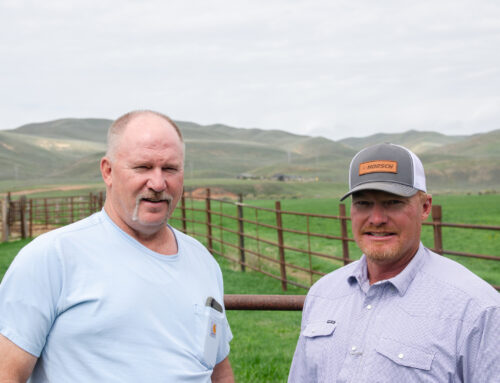Here’s what Colorado lawmakers did — and didn’t — do on climate and environmental issues t
June 9, 2025

Colorado lawmakers in this year’s session took on a wide variety of environmental issues, from the definition of clean energy to the fate of roaming bison.
Legislators had to balance $1.2 billion in needed budget cuts with the necessities of preparing for a drier future — with the prospect of more extreme weather — and sustainably managing the lands, water and wildlife that define the state.
Officials from Gov. Jared Polis’ administration cheered the bills passed this session in a news release Friday. Polis said the laws passed by lawmakers will help the state keep moving in the right direction.
“This legislative session marks a bold leap forward in protecting both community health and our environment,” Jill Hunsaker Ryan, the executive director of the Colorado Department of Public Health and Environment, said in the release. “From tackling air pollution and building decarbonization to supporting environmental justice and water security, Colorado is demonstrating that smart climate policy is also smart public health policy. We’re proud to help lead this work for the well-being of all Coloradans.”
Environmental advocates, however, said progress was mixed — and stymied by the budget cuts as well as a truce between Polis, legislative leaders, and the oil and gas industry.
“The energy and environment committees were tougher this year than they have been historically, both with budget cuts and shifting ideologies,” said Ean Tafoya, the Colorado state director for GreenLatinos.
Legislators passed a bill that added nuclear energy to the state’s definition of clean energy, despite passionate pushback from some environmental and community groups. A bipartisan measure, House Bill 1040, now signed into law, makes nuclear energy projects eligible for financing set aside for clean energy and allows utilities to count energy from nuclear sources toward their clean energy goals.
Lawmakers also considered moving up the deadline for sourcing 100% of the state’s power from clean energy sources to 2040 from 2050, but they ran out of time to introduce legislation to implement the change.
Tafoya expected that effort to return in next year’s session, along with a bill that proposes tax breaks for data centers in exchange for meeting energy efficiency goals.
Impact of oil and gas truce
This year’s session was the first full session since the oil and gas truce was agreed to by leading Democrats and some environmental groups in the last days of the 2024 legislative session.
Both the industry and the environmental groups agreed to drop ballot initiatives set for the 2024 election, while lawmakers agreed to drop bills targeting ozone pollution in exchange for a fee program paid by oil and gas companies to fund public transit. The truce also included a promise that nobody involved would run new ballot measures or legislation for several years.
That truce frustrated some environmental groups that were not part of the negotiations. It also hamstrung efforts to address greenhouse gases — the primary driver of climate change.
“The deal last session … really set us up for not being able to do much on the No. 1 cause for pollution and the climate crisis in our state — the oil and gas industry,” said Heidi Leathwood, a climate policy analyst at 350 Colorado. “The lawmakers in leadership didn’t want to touch anything with oil and gas with a 10-foot pole.”
350 Colorado, a clean energy advocacy group, instead pivoted to support legislation that would have required warning labels on gas pumps and other fuel products stating that using the fuel would release pollutants that cause heath impacts and climate change. The bill did not pass after Polis threatened to veto it, Leathwood said.
Another important bill to environmental groups that also failed would have required employers to implement policies to protect workers from extreme hot and cold temperatures.
“While there are some legislators that are really cognizant of the risk of climate change, and that it’s here and having impacts in Colorado already, we’re also seeing that a lot of legislators may not know the full extent of how fast this is moving and what we need to do to do our part,” Leathwood said.
More budget cuts are expected next year. Tafoya urged lawmakers to remember that addressing climate change will require investment.
“I think that we have to be really prepared to continue to push back on the expected cuts next year and make sure environmental programs aren’t disproportionally cut,” he said.
Lawmakers next year may also face pressure to draft state policy to address environmental protections rescinded by courts and the Trump administration, as when they passed a water pollution regulation last year in the wake of a U.S. Supreme Court decision.
“I would hope that Colorado lawmakers would continue to step up,” said Henry Stiles, an advocate with Environment Colorado. “I would expect to see more of that in the future.”
A run-down of measures passed
Here are some of the environment and climate measures that Polis signed into law:
- A bill that bans the use of nonnative turf — like Kentucky bluegrass — for aesthetic purposes in new apartment and condo complexes. It also requires local governments to regulate the use of nonfunctional turf in a way that reduces water use. House Bill 1113 was the latest in a series of laws in recent years that have curtailed the use of such turf in an attempt to reduce water use amid long-term aridification.
- A bill that classifies wild bison as big game, which means they cannot be legally killed without a hunting license. Proponents of the bill said Senate Bill 53 was necessary to protect wild bison from herds in Utah when they wander into Colorado.
- House Bill 1269, which creates a process for the Air Quality Control Commission to set 2040 standards requiring owners of certain buildings to reduce their greenhouse gas emissions.
- A new law that gives state officials more authority over the herds of wild horses that roam Colorado’s Western Slope. House Bill 1283 gives the state’s Department of Agriculture the authority to implement a fertility control program to regulate the number of horses on the landscape. Federal authorities estimate about 1,400 wild horses are in the state — more than the 800 horses they say would be a sustainable population.
- A law that creates and funds a program that will collect and share data on snowpack levels and conduct research into better ways to measure snowpack and forecast water supply. “In Colorado’s challenging water landscape, we need all the tools in the toolkit,” Lauren Ris, director of the Colorado Water Conservation Board, said in a statement about House Bill 1115.
- A bill that requires local government approval of large-scale fencing projects on Sangre de Cristo Land Grant lands. House Bill 1023 came at the request of Costilla County residents who were fighting the installation of a massive fence around El Cielo Vista Ranch.
That ranch is owned by a Texas oil heir, but local residents retain legal rights for access. The fence caused erosion and blocked wildlife movements, residents said.
“This will enable other counties to protect themselves from the destructive, obscene displays of wealth that the ultrawealthy who are purchasing large mountain tracts in Colorado can engage in in order to separate themselves in their private sanctuaries from the regular people,” said Joseph Quintana, one of the San Luis residents who opposed the fence.
Stay up-to-date with Colorado Politics by signing up for our weekly newsletter, The Spot.
RevContent Feed
Search
RECENT PRESS RELEASES
Related Post








